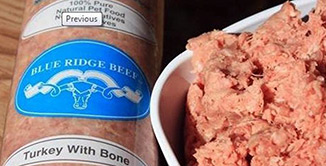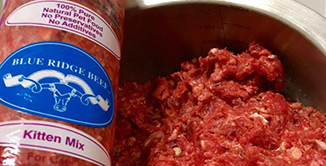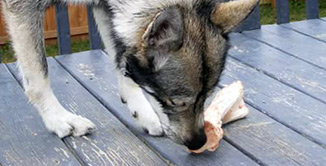- Why should I feed my pet raw food?
- Should I cook the raw food? How do I serve it?
- How do I transition my pet to eating raw food?
- Should I add supplements to my dog’s diet?
- How does "High Pressure Processing" (HPP) work?
- Should I feed my cat different than my dog?
- How does protein in dry food compare to raw food?
Why should I feed my pet raw food?
Dogs and Cats, at the core of their diets, are carnivores. Feeding raw muscle meats, organs, and bones offer proteins, fats, and enzymes that are more biologically available for your pet to utilize. Leaving these nutrients in their natural and unaltered state is what makes feeding raw beneficial. With raw food, what you see is exactly what it is. There are no hidden ingredients and no fillers. A raw diet is composed of the same food you eat, but nothing is cooked.
Feeding closer to your companion’s natural diet will release abounding health benefits noticeable in the coat and skin, oral health, and general well-being of your pet:
- Shinier, healthier skin
- Fresher breath and cleaner teeth
- Improved digestion
- Improvement with allergy symptoms
- Decreased shedding
- Increased stamina
- Firmer, smaller stools
- A general increase in overall health
Raw is the most natural of all foods. Highest quality protein, muscle building, living tissues and bone provide the natural source of nutrients absolutely necessary for good health in dogs and cats. In the wild, cats and dogs did not have little cooked pellets that contained cooked vegetables and grains, (or cooked meat, for that matter), thus their systems are not made for digesting these ingredients. A raw diet is a direct evolution of what cats and dogs ate before they became our pets.
Grains are completely unnecessary, since commercial pet foods are always grain-based diets, many people are used to the idea that their dogs need grain. This is not true. Some of the positive effects of feeding raw are related to eliminating grain from your dog’s diet.
Raw bones are beneficial for your dog’s dental hygiene. Raw knuckle bones (the joints) in particular are great, because they are soft and still have some tendons and muscle meat attached. These bones clean your dog’s teeth in addition to providing them with a nice oral workout – not to mention a healthy dose of natural calcium. Raw knuckle bones are soft and allow dogs of all sizes to scrape their teeth into the bone, nicely cleaning food and tartar from their teeth. A raw bone is not going to splinter. NEVER feed cooked bones! Cooked bones run the risk of splintering.
Should I cook the raw food? How do I serve it?
We do not recommend cooking raw products, because the point of feeding for health is to maintain optimum nutritional sources as best as possible. Enzymes and nutritional values are lost in the cooking process. Keep raw foods frozen until it is ready to use.
As with any raw meat, certain practices are recommended. Keep the raw meat frozen and thaw in refrigerator or in cold water. Never leave raw meat out at room temperature for long periods of time. Always wash hands, food bowls, and cutting boards with warm soapy water. To quickly thaw chubs or prepared medallions in a bag, place in a cold water bath until thawed. If the food is not eaten at the feeding time, immediately refrigerate leftover product and feed within 24 hours.
HUMANS should NOT eat raw meat: Raw meat is not safe for humans because of bacteria like e-coli and Salmonella. But when a dog is in good overall health, canine digestive systems are have some natural immunity to bacteria, and can handle the bacteria in meat without issue.
How do I transition my pet to eating raw food?
A dog on a raw diet should eat several different meats. For example, one type of meat may be higher in iron; while another may be higher in vitamin A. This is why a rotating diet is recommended in order to maintain a healthy raw diet. When you first start your dog on raw, introduce one protein source at a time. Feed chicken for a week, then beef for a week, and so on, to introduce these foods to your pet’s system. This way you can easily detect a protein allergy.
Remember that some digestive upset is normal during a transition. This may show up as diarrhea, constipation or (very rarely) vomiting. It will eventually subside as your pet adjusts to the new food. Some pets may take longer or shorter times to transition. Use the following guide with Blue Ridge Beef raw pet food:
- Day 1-3: 25% raw food with 75% current diet
- Day 4-6: 50% raw food with 50% current diet
- Day 7-9: 75% raw food with 25% current diet
- Day 10+: 100% raw food
The general rule is to feed a healthy adult dog between 2-4% of its ideal weight daily, and then adjust as needed. If you have an overweight dog, start on the lower end of the spectrum; if you have a dog that needs to gain a little bit of weight, start closer to 4%. Raw diets are ideal for growing puppies. Puppies may require up to 10% of their weight daily.
Should I add supplements to my dog’s diet?
Dogs require a vast array of amino acids that are only found in meat. For example, eating green tripe raw gives the dog essential fatty acids, amino acids and lactic acids to aid in digestion and processing of a high-protein diet, while its rubbery texture strengthens jaws and helps keep teeth clean. Consult your vet or our team of experts for additional recommendation based on the needs of your pet.
Your pet is a carnivore with a digestive system and process designed to break down and assimilate protein, bones, and fat. Their stomachs have a much higher level of hydrochloric acid to digest and assimilate meat protein. Dogs are surprisingly well-equipped to deal with bacteria. Their saliva has antibacterial properties; it contains lysozyme, and enzyme that destroys harmful bacteria. Their short digestive tract is designed to push through food and bacteria quickly without giving bacteria time to colonize. The extremely acidic environment in the gut is also a good bacteria colonization deterrent. Raw meat diets are easily digestible and have no carbohydrates.
How does "High Pressure Processing" (HPP) work?
HPP is a cold water process that applies pressure on our foods that fractures the cell walls of pathogenic bacteria such as Salmonella, E. coli 0157:H7, and Listeria Monocytogenes. The process kills the bacteria, while leaving all nutrients intact. During this process in which the product is immersed in a pressurized container with water and put under 87,000 psi for a short amount of time, the product never reaches a temperature above 38°F, and after a hold period, the product is placed in a blast freezer for freezing.
Blue Ridge Beef uses HPP in processing its raw meat. This process effectively kills all harmful bacteria in the product while leaving proteins and enzymes intact and unchanged so pets receive the same amount of nutrition.
Should I feed my cat different than my dog?
Cats are designed by mother nature to eat high protein diets that are very low in carbohydrates, and we have raw foods best suited for cats. The raw food dietary model is beneficial for cats, because their digestive systems are very acidic and short, which means they have a limited amount of time to extract the nutrients they need from their food. They need to digest food quickly and effectively, and raw food is perfect for their specialized physiology, as nutrients are in their most bio-available form.
Feeding a raw diet closely mirrors what cats would naturally eat in the wild and provides a broad range of benefits that include:
- Healthy skin and coat – Many cats are allergic to grains, which can lead to pathologic conditions
- Naturally, clean teeth – Many dry foods leave a starchy coating on teeth, which promotes plaque. Feeding a raw diet can lead to healthier teeth and gums.
- Decreased litter box odor – Many pet foods include a protein that is indigestible, which leads to an undesirable odor at the litter box.
- Natural weight control – Cats are healthiest on a high protein, low carbohydrate diet.
- Increased energy and vitality – Cat’s digestive systems are designed to ingest raw meat and are healthiest eating what nature intended.
Water is an extremely important nutrient that contributes to overall health in every living creature. Cats are designed to obtain most of their water with their diet since their normal prey contains approximately 70-75% water. Dry foods only contain 1-10%.
How does protein in dry food compare to raw food?
The protein in dry food, which is often heavily plant-based, is not equal in quality to the protein in meat. Plant proteins are cheaper than meat proteins, and so pet food companies will have a higher profit margin when using corn, wheat, soy, rice, etc. Pets lack specific metabolic (enzymatic) pathways and cannot utilize plant proteins as efficiently as animal proteins.
Also, the protein contained in dry food has been cooked at very high temperatures for a long period of time. Over-cooked, over-processed canned and kibbled products decrease the biological value of the protein sources and other natural nutritional value of food. On the labels of cooked products, there is a long list of supplements that have to be added due to the destruction of the naturally present vitamins and other nutrients originally contained in the ingredients.


